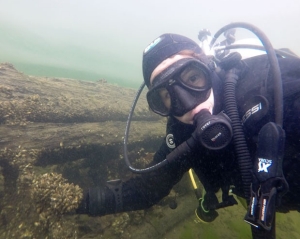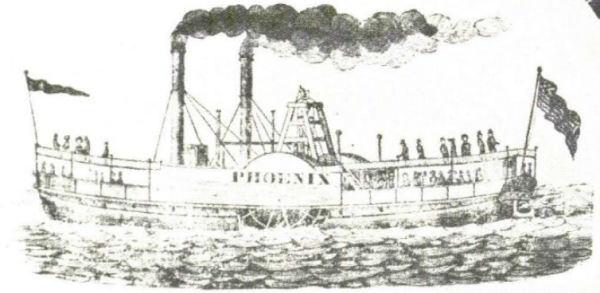As an archaeologist, what fascinates you about steamboats?
CK: “For thousands of years, boats had been powered by wind or manpower, restricted by how long a person can row or paddle, or by the speed and direction of the wind. In 1807, all of a sudden you have a steam engine — powered by coal or wood — that can propel the boat more reliably and on a schedule.
Imagine how this must have looked to people in the 1800s — putting a fire on a wooden hull in the water. It was exciting!
My research looks at passenger boats — elegant vessels with huge paddle wheels, gilded moldings and mahogany railings. At the time, this was how people got around, like our cars or buses today.
About the Phoenix II specifically, we have the captain’s journal. That’s how we know the first cholera death in North America occurred on Phoenix II, coming from Montreal.
The Phoenix II brought cholera into the U.S., then the bacteria travelled down to New York City, killing thousands, and so on. It’s horrible, but of great historical significance — and is an amazing historical link to this boat.”
How did your studies at Concordia help you get where you are today?
CK: “I discovered my interest in archaeology at Concordia. I took an intro course with Jane Francis [associate professor in the Department of Classics, Modern Languages and Linguistics], which really opened my eyes.
Dr. Francis, to this day, is a role model to me. Her archaeological work in Crete is fascinating, and she’ll always be a favourite professor! She encouraged me to apply to Texas A&M University for graduate school.
When I mentioned an interest in nautical archaeology, Dr. Francis encouraged me to find a field school to try it out and see if I really wanted to go into that. And I did. I found one in Menorca, Spain, and the following year, I came across a program at the Lake Champlain Maritime Museum.
It was a fluke. I’d grown up around Lake Champlain and never connected it to archaeology in any way whatsoever — until I found that school online, which eventually led to my PhD research on the lake.”
#CUalumni



 Kennedy examines one of the steamboat wrecks in Shelburne Shipyard. | Photo courtesy of Carolyn Kennedy
Kennedy examines one of the steamboat wrecks in Shelburne Shipyard. | Photo courtesy of Carolyn Kennedy
 Carolyn Kennedy holds an important piece of evidence in identifying the Phoenix II — a chisel inscribed with the boat’s name, recovered from the wreck. | Photo courtesy of Carolyn Kennedy
Carolyn Kennedy holds an important piece of evidence in identifying the Phoenix II — a chisel inscribed with the boat’s name, recovered from the wreck. | Photo courtesy of Carolyn Kennedy
 The Phoenix II probably resembled this steamboat woodcut used to advertise Lake Champlain steamboats in local newspapers. | Source: The Steamboats of Lake Champlain: 1809-1930 (Vermont Heritage Press, 1997)
The Phoenix II probably resembled this steamboat woodcut used to advertise Lake Champlain steamboats in local newspapers. | Source: The Steamboats of Lake Champlain: 1809-1930 (Vermont Heritage Press, 1997)